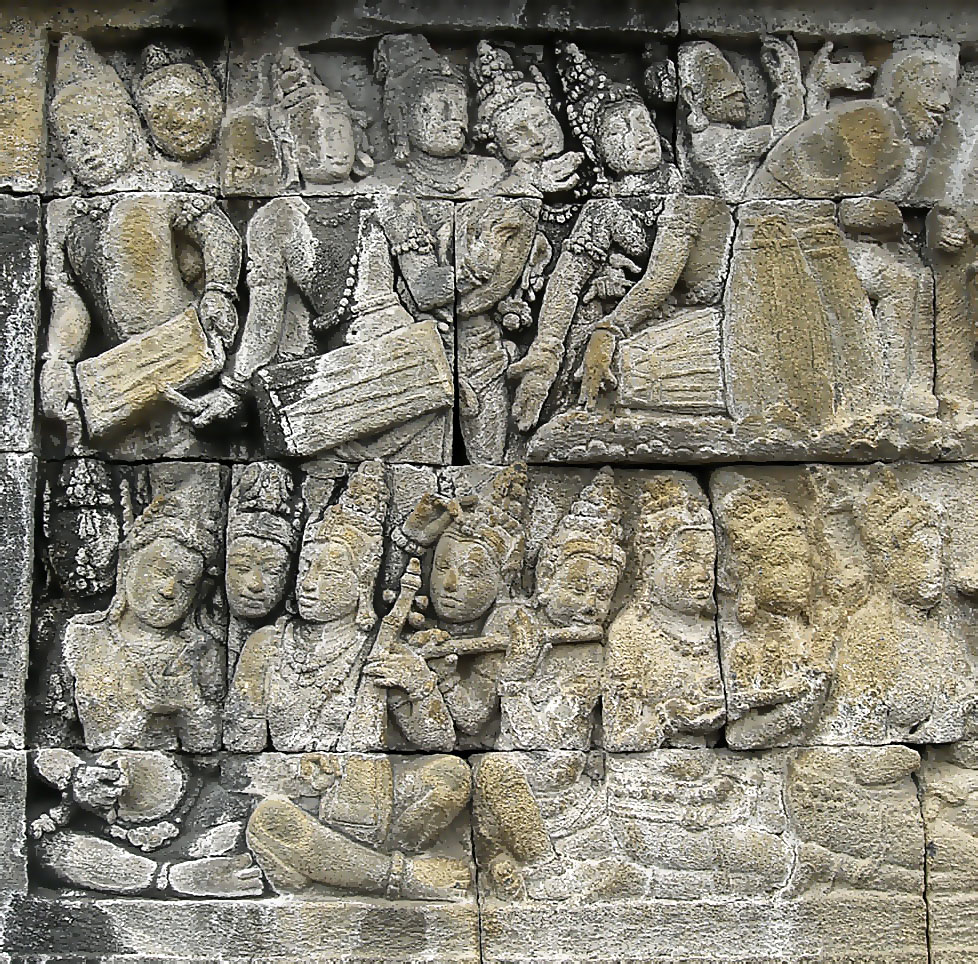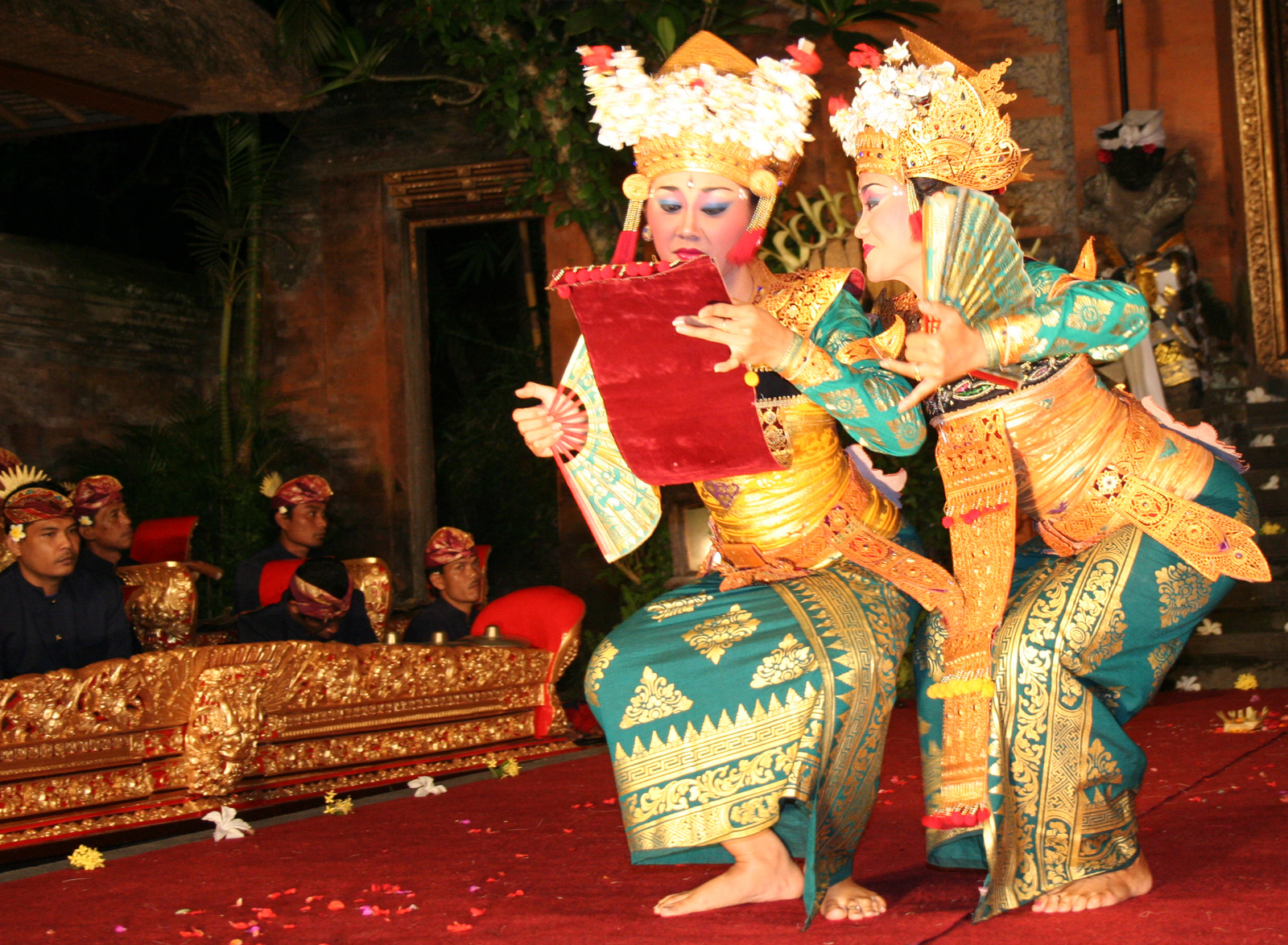|
Legong
Legong ( Balinese: ) is a form of Balinese dance. It is a refined dance form characterized by intricate finger movements, complicated footwork, and expressive gestures and facial expressions. Origins Legong probably originated in the 19th century as royal entertainment. Legend has it that a prince of Sukawati fell ill and had a vivid dream in which two maidens danced to gamelan music. When he recovered, he arranged for such dances to be performed in reality. Others believe that the Legong originated with the '' sanghyang dedari'', a ceremony involving voluntary possession of two little girls by beneficent spirits. Legong is also danced at public festivals. Excerpts from Legong dance dramas are put on for tourists. Dancers Traditionally, legong dancers were girls who have not yet reached puberty. They begin rigorous training from about the age of five. These dancers are regarded highly in the society and usually become wives of royal personages or wealthy merchants. After marr ... [...More Info...] [...Related Items...] OR: [Wikipedia] [Google] [Baidu] |
Condong
( ban, ᬘᭀᬦ᭄ᬤᭀᬂ) is a Balinese dance which is often performed as a preface to legong and accompanied by the semar pangulingan style of gamelan. The term also refers to a stock character, a quintessential representation of the maidservant, found in the condong dance, as well as the legong, gambuh, and arja dances. History The condong dance originated in the by palaces of Bali in the mid-19th century. Its creator is not known, but folk history suggests that a prince of Sukawati, deathly ill, saw a vision of two beautiful girls dancing gracefully while accompanied by gamelan music; upon regaining his health, this prince recreated the dance he had seen. It originally told the story of two ''bidadari'' (nymphs) named Supraba and Wilotama. By the 1930s the story had been modified, telling of a king or queen and their subject. In current performances, the condong dancer plays the role of the subject. The choreographer Ni Ketut Arini describes the condong dancer as p ... [...More Info...] [...Related Items...] OR: [Wikipedia] [Google] [Baidu] |
Gamelan
Gamelan () ( jv, ꦒꦩꦼꦭꦤ꧀, su, ᮌᮙᮨᮜᮔ᮪, ban, ᬕᬫᭂᬮᬦ᭄) is the traditional ensemble music of the Javanese, Sundanese, and Balinese peoples of Indonesia, made up predominantly of percussive instruments. The most common instruments used are metallophones played by mallets and a set of hand-played drums called '' kendhang/Kendang'', which register the beat. The kemanak (a banana-shaped idiophone) and gangsa (another metallophone) are commonly used gamelan instruments in Bali. Other instruments include xylophones, bamboo flutes, a bowed instrument called a ''rebab'', a zither-like instrument '' siter'' (in Javanese ensemble) and vocalists named '' sindhen'' (female) or ''gerong'' (male).Sumarsam (1998)''Introduction to Javanese Gamelan'' Middletown. Although the popularity of gamelan has declined since the introduction of pop music, gamelan is still commonly played in many traditional ceremonies and other modern activities in Indon ... [...More Info...] [...Related Items...] OR: [Wikipedia] [Google] [Baidu] |
Sanghyang
( ban, ᬲᬂᬳ᭄ᬬᬂ) is a traditional sacred Balinese dance originated from the Indonesian island of Bali, it is based on the premise that an unseen force enters the body of an trance, entranced performer. The force, identified as ''hyang'', is an important type of spiritual entity in ancient Mythology of Indonesia, Indonesian mythology. The ''sanghyang'' dances are considered sacred ritual dances and are performed exclusively at Balinese temple, Balinese religious ceremonies. Variants ''Sanghyang bojog'' The dancer is a man dressed like a monkey (''bojog'') and accompanied by a chorus of chanting ''sanghyang''. Before it begins, the dancer goes through the phases of summoning ape spirits. After conceding, the dancer will jump into a tree and mimic the behavior of an ape. This dance is only found in Bugbug, Bugbug, Karangasem. ''Sanghyang celeng'' This is a ''sanghyang'' dance variant only found in Karangasem Regency, Duda, Karangasem, danced by a man wearing palm f ... [...More Info...] [...Related Items...] OR: [Wikipedia] [Google] [Baidu] |
Dance Of Indonesia
Dance in Indonesia ( id, Tarian Indonesia) reflects the country's diversity of ethnicities and cultures. There are more than 1,300 ethnic groups in Indonesia. Austronesian roots and Melanesian tribal forms are visible, and influences ranging from neighboring Asian and even western styles through colonization. Each ethnic group has its own dances: there are more than 3,000 original dance forms in Indonesia. The old traditions of dance and drama are being preserved in the many dance schools which flourish not only in the courts but also in the modern, government-run or supervised art academies. For classification purposes, the dances of Indonesia can be divided according to several aspects. In the historical aspect it can be divided into three eras; the prehistoric-tribal era, the Hindu-Buddhist era, and the era of Islam. According to its patrons, it can be divided into two genres; court dance and folk dance. In its tradition, Indonesian dances can be divided into two types; ... [...More Info...] [...Related Items...] OR: [Wikipedia] [Google] [Baidu] |
Sanghyang
( ban, ᬲᬂᬳ᭄ᬬᬂ) is a traditional sacred Balinese dance originated from the Indonesian island of Bali, it is based on the premise that an unseen force enters the body of an trance, entranced performer. The force, identified as ''hyang'', is an important type of spiritual entity in ancient Mythology of Indonesia, Indonesian mythology. The ''sanghyang'' dances are considered sacred ritual dances and are performed exclusively at Balinese temple, Balinese religious ceremonies. Variants ''Sanghyang bojog'' The dancer is a man dressed like a monkey (''bojog'') and accompanied by a chorus of chanting ''sanghyang''. Before it begins, the dancer goes through the phases of summoning ape spirits. After conceding, the dancer will jump into a tree and mimic the behavior of an ape. This dance is only found in Bugbug, Bugbug, Karangasem. ''Sanghyang celeng'' This is a ''sanghyang'' dance variant only found in Karangasem Regency, Duda, Karangasem, danced by a man wearing palm f ... [...More Info...] [...Related Items...] OR: [Wikipedia] [Google] [Baidu] |
Balinese People
The Balinese people ( id, suku Bali; ban, ᬳᬦᬓ᭄ᬩᬮᬶ, anak Bali) are an Austronesian people, Austronesian ethnic group native to the Indonesian island of Bali. The Balinese population of 4.2 million (1.7% of Indonesia's population) live mostly on the island of Bali, making up 89% of the island's population. There are also significant populations on the island of Lombok and in the easternmost regions of Java (island), Java (e.g. the regency of Banyuwangi). Origins The Balinese originated from three periods of migration. The first waves of immigrants came from Java and Kalimantan in prehistoric times and were of Proto-Malay stock. The second wave of Balinese came slowly over the years from Java during the Hindu period. The third and final wave came from Java, between the 15th and 16th centuries, about the same time as the conversion to Islam in Java, causing aristocrats and peasants to flee to Bali after the collapse of the Javanese Majapahit, Hindu Majapahit Empi ... [...More Info...] [...Related Items...] OR: [Wikipedia] [Google] [Baidu] |
Frontline (Redgum Album)
''Frontline'' is the fourth studio album by the Australian folk-rock group Redgum. It was the last album that John Schumann performed on before he left the group at the end of 1985.That Striped Sunlight Sound bloFrontline review/ref> Track listing Personnel The Band * Michael Atkinson – vocals, guitar * Hugh McDonald – acoustic and electric guitars, violin, vocals * John Schumann – vocals, acoustic guitar * Verity Truman – saxophone, flute, vocals * Stephen Cooney - bass, didgeridoo, guitar, mandolin, banjo, vocals * Brian Czempinski - drums * Michael Spicer - piano, keyboards Guests * Mick O'Connor - Hammond organ * Michael Harris - violin * Dobe Newton - lagerphone * Wilbur Wilde - saxophone * Bill Harrower - saxophone, alto flute * Trevor Lucas - guitar * Greg Sheehan - percussion * Tim Fetters - trumpet Technical * Trevor Lucas - producer * Tony Buettel - engineer * Richmond Recorders - recording studio * Music Farm Studios - mixing studio Design * A&L Barnu ... [...More Info...] [...Related Items...] OR: [Wikipedia] [Google] [Baidu] |
Redgum
Redgum were an Australian folk and political music group formed in Adelaide in 1975 by singer-songwriter John Schumann, Michael Atkinson on guitars/vocals, Verity Truman on flute/vocals; they were later joined by Hugh McDonald on fiddle and Chris Timms on violin. All four had been students at Flinders University and together developed a strong political voice. They are best known for their protest song exploring the impact of war in the 1980s " I Was Only 19", which peaked at No. 1 on the National singles charts. NOTE: Used for Australian Singles and Albums charting from 1970 until ARIA created their own charts in mid-1988. The song is in the Australasian Performing Right Association (APRA) list of Top 30 of All Time Best Australian Songs created in 2001. Redgum also covered Australian consumer influences on surrounding nations in 1984's "I've Been to Bali Too", both hit singles were written by Schumann. Note: requires user to input song title, e.g. I WAS ONLY NINETEEN "T ... [...More Info...] [...Related Items...] OR: [Wikipedia] [Google] [Baidu] |
Dance Of The Virgins
Dance is a performing art form consisting of sequences of movement, either improvised or purposefully selected. This movement has aesthetic and often symbolic value. Dance can be categorized and described by its choreography, by its repertoire of movements, or by its historical period or place of origin. An important distinction is to be drawn between the contexts of theatrical and participatory dance, although these two categories are not always completely separate; both may have special functions, whether social, ceremonial, competitive, erotic, martial, or sacred/liturgical. Other forms of human movement are sometimes said to have a dance-like quality, including martial arts, gymnastics, cheerleading, figure skating, synchronized swimming, marching bands, and many other forms of athletics. There are many professional athletes like, professional football players and soccer players, who take dance classes to help with their skills. To be more specific professional athletes ta ... [...More Info...] [...Related Items...] OR: [Wikipedia] [Google] [Baidu] |
Balinese Dances
Balinese dance ( id, Tarian Bali; ban, ᬇᬕᬾᬮᬦ᭄ᬩᬮᬶ) is an ancient dance tradition that is part of the religious and artistic expression among the Balinese people of Bali island, Indonesia. Balinese dance is dynamic, angular and intensely expressive. Balinese dancers express the stories of dance-drama through the bodily gestures including gestures of fingers, hands, head and eyes. There is a great richness of dance forms and styles in Bali; and particularly notable are those ritualistic dance dramas which involve Rangda, the witch, and the great beast Barong (mythology), Barong. Most of the dances in Bali are connected to Hindu or traditional folk rituals, such as the Sanghyang Dedari sacred dance that invoke benevolent hyang spirits, believed to possess the dancers in a trance state during the performance. Other Balinese dances are not linked to religious rituals and are created for certain occasions or purposes, such as the Baris (dance), Baris or Pendet we ... [...More Info...] [...Related Items...] OR: [Wikipedia] [Google] [Baidu] |


.jpg)


